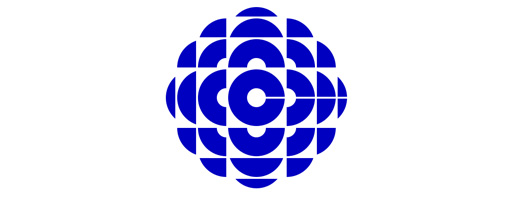Source: CBC
CBC's logo has been an ever evolving and sometimes controversial corporate stamp. Stylized maps framed by lightning bolts, a colourful butterfly, and several iterations of the iconic gem have come to represent the public broadcaster to viewers, listeners and readers.
1940
Created by Hortense Binette, student from Montréal's École des Beaux Arts, who won a design contest organized by Radio-Canada in April 1940.
CONCEPT: A red map of Canada set above elongated lightning bolts spanning across the country, the design was intended to represent the unifying role the public broadcaster would play.
1958
Created by Jean-Paul Boileau, who constructed scale models used in Radio-Canada productions.
CONCEPT: CBC / Radio-Canada had to redesign their logo to conform to television standards and wanted to convey the CBC brand in a global context while highlighting the public broadcaster's national importance.
1966
Created by Hubert Tison, who headed up Radio-Canada's animation department and went on to produce the Oscar-nominated documentary short The Mighty River (1994).
CONCEPT: The rainbow butterfly logo was unveiled with the introduction of colour TV, and would be used for eight years with the accompanying voiceover, "This is a CBC colour presentation."
1974
Created by Burton Kramer, a designer and artist whose work is featured as part of the permanent collection at the Smithsonian Institute.
CONCEPT: Sometimes called the exploding pizza or pineapple, Burton Kramer's modernist logo features the letter "C" for Canada at its core. According to the CBC's 1974 corporate manual, "the overall shape is globular, conveying the corporation's international responsibilities in addition to its national role.”
1985
Created by Hubert Tison, who designed the 1966 butterfly logo, and Robert Innes.
CONCEPT: With Burton Kramer's approval, Hubert Tison and Robert Innes modified the multi-coloured gem to make it easier to reproduce in other media. The shades of orange were shed in favour of a solid blue.
1992
Created by Swiss-Canadian design firm Gottschalk + Ash, in a further revision of Burton Kramer's 'gem'.
CONCEPT: In 1992, CBC undertook a new branding strategy and opted to revise Burton Kramer's 1974 logo yet again. When the contract was awarded to a rival firm Gottschalk + Ash, Kramer objected that, unlike the work on the 1986 redesign, his original gem would be altered without his approval and participation. CBC countered that they owned the symbol and could revise as they chose.
Behind The Design takes a look interesting tidbits in the world of design. From the history of identities to pictogenes, geons and the science of visual communication. Follow us as we explore those things you may never would have thought of.






